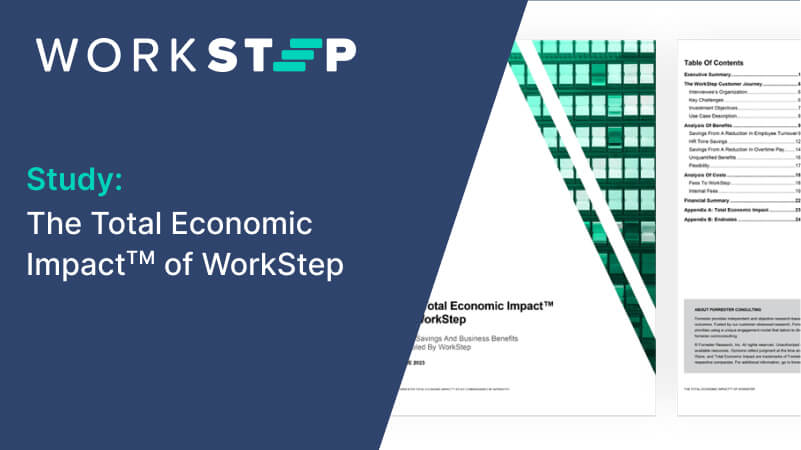Workforce Management Strategies
From benefits to behavior: How HR decision-making impacts the bottom line
October 10, 2023
Today, Human Resources (HR) decision-making is one of the most challenging aspects of running a business. As companies strive to remain competitive and profitable, it’s essential to understand the nuances of HR decisions and their financial impacts. From understanding the cost of employee attrition to anticipating behavioral outcomes and closing the loop, HR departments have a responsibility to ensure that their organization is making smart decisions for long-term success.
Our very own Dan Johnston, Chief Executive Officer of WorkStep, sat down with Daniel Berenbaum, Chief Financial Officer at NI (National Instruments), a test and measurement company which provides solutions for engineers to test complex global technologies. Without their work, our electric vehicles won’t drive, our airplanes won’t fly, and many of the fundamental technologies we rely on today would not be possible.
The importance of retaining talent in today’s competitive market is unparalleled. Yet, often, HR and finance departments find themselves at odds when discussing employee compensation, benefits, and the true cost of attrition. Bringing these two perspectives together ensures company health and satisfied employees. We’ll explore how the two can work seamlessly together, using real-life anecdotes from an industry veteran.
Understanding the cost of frontline attrition
Berenbaum knows that attrition is an unavoidable fact of life in any business, but encourages his team to understand the associated costs and impacts to make sound decisions.
Berenbaum believes that putting the time into research is essential to understanding the long-term effects so his team can act accordingly. For example, if organizations have high rates of turnover due to poor wages or working conditions, it could lead to lower customer satisfaction ratings and decreased profits in time. Conversely, firms that keep their staff loyal with competitive salaries and attractive benefits may reap higher profits down the line.
Modern organizations have become successful at managing attrition by engaging employees through open communication channels and offering development opportunities. This helps workers feel valued leading to increased job satisfaction, reduced turnover rates and improved customer experience ratings.
At the core of any employee retention strategy is understanding the cost of losing a team member. While it’s tempting to measure this only in salary and recruitment expenses, the reality is far more complex. Berenbaum explains, “If you have very highly skilled employees like PhD-level/masters-level engineers… on average, you would think about between nine months and one year of compensation as the cost of attrition. The time it takes, the value it takes to bring somebody new into the organization to train them up to get them to the point of their competency, to be able to replace that person that you lost.”
Ultimately, taking into account all associated costs, both tangible and intangible, while keeping an eye on ROI (return on investment) will assist HR pros in designing effective compensation packages that attract qualified talent without being overly costly for the business.
Presenting benefits through the lens of ROI
Seeking approval for enhanced employee benefits and programs can be a daunting task for HR professionals. Often, the challenge lies in communicating the potential return on investment (ROI) to the CFO. Berenbaum shares a real-life example from his time at a previous company: When HR proposed enhancing the dental plan, his first question wasn’t about the cost but about the ROI. Berenbaum asks, “Do you believe this will help me retain valued employees? Is that a reason that our employees have given during exit interviews for leaving? Would employees walk across the street over a difference in dental benefits? And what is the market doing?” These are essential considerations, as CFOs must balance employee satisfaction with the company’s financial health.
A significant concern for CFOs is the discrepancy between anticipated and realized returns on HR decisions. To help close this gap, companies should routinely use surveys to gauge employee sentiment. Berenbaum recommends organizations evaluate the behavior of their staff in relation to any changes made that could influence morale or engagement levels. They should have strategies set in place for ensuring their expectations align with reality when it comes to ROI for HR programs, such as dedicating additional training or resources where needed and providing employees with ample information about changes being implemented.
A key insight gleaned from our conversation comes from the simple notion that employee engagement activities take time. This is to say that it takes time away from employee’s day when they have to stop and answer questions, it takes time for managers to sort through the data, it takes time for the executive leadership team to understand and formulate a solution. Berenbaum places the onus on himself and his team to do something meaningful with that data, citing the failures of many organizations who have the right tools in place but no process to realize the return potential hidden in the data.
The power of market research and the importance of anticipating behavioral outcomes
It’s unrealistic to think that companies can offer infinite pay raises or promotions. At some point, a balance must be found between an employee’s contribution and their compensation. This is where managers play a crucial role. They can help gauge performance, effectively assess the value an individual brings to the company and provide a fair compensation package.
Berenbaum highlights that predicting behavioral results is a vital ingredient in making informed HR decisions. Rather than simply examining the financial aspect of an employee’s job, organizations should consider how different incentives can produce a desired behavior. To gain insights into what works best for frontline personnel, employee surveys and feedback loops should be used, as well as data analytics to tailor solutions precisely to their needs.
For instance, Berenbaum discussed how he would handle a situation where market research suggested that the organization’s dental plan was well over the regional average and beyond what was expected. His solution was to reallocate those funds into increased base pay, which is something that his employees would actually notice and appreciate.
Establishing a culture where employees feel motivated and supported is also important; initiatives such as flexible hours or career advancement options will encourage employee engagement while also improving the organization’s reputation for potential hires down the line.
Continuous employee feedback and closing the loop with your frontline
The HR decision-making process is always changing, but one thing remains constant: employee behavior and feedback will always play a major role in establishing the success or failure of policies. For informed decisions that improve financial outcomes, continuous feedback and closing the loop are crucial.
Berenbaum tackles this problem from two directions — with surveys to measure satisfaction in the workplace and customer feedback loops. This data gives insight into how employees react to changes and what incentives prove most effective for them, informing leadership during decision-making time on compensation, job roles and career advancement opportunities.
Creating an environment where employees feel supported, engaged and valued should be a priority for organizations, with feedback being a key part of this practice. By closing the loop, Berenbaum ensures his organization can observe employee behavior more closely and determine if the ROI expectations align with reality. Incorporating ongoing feedback also allows companies to allocate resources efficiently, identify areas that require additional training, maximize efficiency gains and provide their workers with a positive employment experience.
Conclusion
HR decision-making is a complex area with many nuances that can make or break a business financially. By understanding these nuances and taking proactive steps to address them, businesses can ensure a sustainable competitive advantage for years to come. It’s not only about making sure that there are enough people to do the job, but also making sure that those people are working efficiently and productively, and that they have a positive experience while doing so.
The bridge between HR and finance isn’t as vast as it seems. Through clear communication, data-driven decisions, and continuous feedback, companies can create a thriving environment that both attracts and retains top talent. The fusion of these two worlds is not just beneficial but essential in the modern corporate landscape.
Close the loop with employee feedback tools
Show your employees that their voice matters. Empower your HR and Operations teams to action on employee feedback and close the loop with your frontline with WorkStep.
Tom Goyette, Product Marketing Manager | tom.goyette@workstep.com
Tom Goyette is a Product Marketing Manager at WorkStep. With experience in start-up and enterprise level SaaS and eCommerce organizations, Tom excels at managing and creating content, marketing, and analytics. Tom believes people are at the center of every great organization and is eager to share stories that highlights the value of the employee voice.



